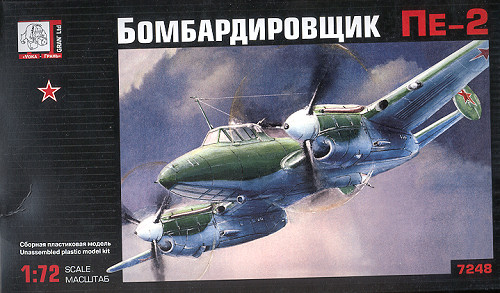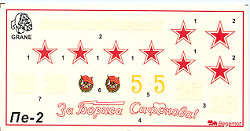
| KIT: | Gran 1/72 Pe-2 |
| KIT #: | 7248 |
| PRICE: | $12.00 at www.wingsntreads.com |
| DECALS: | Three options |
| REVIEWER: | Scott Van Aken |
| NOTES: |

| HISTORY |
"The Pe-2 was designed in a sharashka after Vladimir Petlyakov had been arrested and imprisoned in 1937 for allegedly deliberately delaying design work on the Tupolev ANT-42 bomber. In the sharashka, Petlyakov was put in charge of a team to develop a high-altitude fighter escort for the ANT-42 under the designation VI-100. The first of two prototypes flew on December 22, 1939 and was a very sophisticated aircraft for its time, featuring a pressurized cabin, all-metal construction, superchargers and many electrically-actuated systems. The prototypes proved so pleasing that production was ordered almost immediately. It is said that Petlyakov and his team could see the VI-100 prototype from their prison as it was put through its paces for the crowds watching the annual May Day parade in 1940. Some early sources say the Pe-2 is based on the Potez 63. This does not seem to be the case.
Just as production was ready to begin, the air force ordered a re-design of the aircraft. The value of tactical bombing had just been displayed by the Luftwaffe in the Blitzkrieg, and the need for such an aircraft suddenly became much more important than the need for a high-altitude escort fighter. Petlyakov's team was given 45 days to redesign their aircraft as a dive bomber. The cabin pressurization and superchargers were deleted, and dive brakes and a position for a bombardier were added, among a number of aerodynamic refinements. A fuselage bomb-bay was added, along with smaller bays in each engine nacelle. Initially designated PB-100, Stalin was impressed enough with Petlyakov to free him, and his name was permitted to be used in the aircraft's designation. The first aircraft flew on December 15, 1940, rushed through production without a prototype under severe threats from Stalin if a Pe-2 did not fly by the end of the year. Deliveries to combat units began the following Spring.
The aircraft did not really show its true potential until the end of the year, after the Soviet Air Force had a chance to regroup after the German onslaught during the Winter. The Pe-2 quickly proved itself to be a highly capable aircraft, capable of eluding the Luftwaffe's interceptors and allowing their crews to develop great accuracy with their bombing. Throughout 1942 the design was steadily refined and improved, in direct consultation with pilots who were actually flying them in combat. The product of this evolutionary development was the Pe-2FT variant, where FT stands for Frontovoe Trebovanie(Frontline Request).
A large number of minor variants were also developed, including a dedicated trainer version (Pe-2UTI), a heavily-armed version (Pe-2M) and a rocket-boosted version (Pe-2K). A fighter version (Pe-2I) and radial-engined version (Pe-2K) were put into limited production as the Pe-3 and Pe-4 respectively.
Air forces that continued to fly the Pe-2 after the war included those of Czechoslovakia, China, Poland, and Yugoslavia. In total, around 11,000 were built.
While the Pe-2 general featured favorable flying characteristics when airborne, it took a good amount of force the pull the elevators up to get the plane rotated off the runway during takeoff. Russian night bombing missions often flew with female pilots and some of the women pilots were not sufficiently strong enough to get the airplane airborne by themselves. When such a situation occurred, the procedure was to have one of the crew get behind the pilot's seat and wrap her arms around the control wheel and help the pilot force the wheel back. Once the aircraft was airborne, the crew returned to her duties and the pilot continued to fly the plane without assistance."
Once again, http://en.wikipedia.org comes through.
| THE KIT |
 Molded
in both white and a more translucent plastic, the first thing you spot is that
this one has flash to varying degrees on most of the parts. Detailing is
generally nicely done raised rivet detail as you would normally associate with a
KP kit of the 70s. This is not a bad thing as it looks to be fairly well
executed. The flash or heavy mold lines means careful clean-up before use and
the rather large sprue gates means that the finer parts will need additional
care when removing them. A second set of fuselage halves, undoubtedly meant for
a different variant are included, but not used.
Molded
in both white and a more translucent plastic, the first thing you spot is that
this one has flash to varying degrees on most of the parts. Detailing is
generally nicely done raised rivet detail as you would normally associate with a
KP kit of the 70s. This is not a bad thing as it looks to be fairly well
executed. The flash or heavy mold lines means careful clean-up before use and
the rather large sprue gates means that the finer parts will need additional
care when removing them. A second set of fuselage halves, undoubtedly meant for
a different variant are included, but not used.
The interior and cockpit are fairly well detailed with lots of bits and pieces, many of which will be hidden once the fuselage halves are assembled. The instructions are quite detailed on the placement of all the various bits. Some have to be trimmed and some have to be made from stretched sprue. The various dimensions are provided. One has the option of building the kit with wheels up should you wish, but no stand is provided. A nice touch are separate outer flaps that can be displayed lowered if you wish. The transparencies have good shape but are not crystal clear, having stress lines and other detritus in the plastic that makes them less than transparent.
 Instructions
are well written and in both English and Russian, though many of the notes are
only in Russian. A generic paint chart is provided for the various colors. The
construction drawings are quite well done and clear.
Instructions
are well written and in both English and Russian, though many of the notes are
only in Russian. A generic paint chart is provided for the various colors. The
construction drawings are quite well done and clear.
Markings are given for three aircraft, all in green over light blue. The units are unknown as I can't read Russian. Two have patriotic slogans on the fuselage and one has some light brown and black in with the upper surface green.
My thanks to www.wingsntreads.com for the preview kit. Get yours today at discount.
| CONCLUSIONS |
If you would like your product reviewed fairly and quickly by a site that has over 300,000 visitors a month, please contact me or see other details in the Note to Contributors.